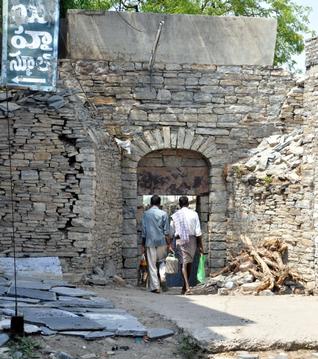
Gopal Darwaza, popularly known as ‘Gopal Diddi’, a dilapidated structure on the bank of Tungabhadra river speaks volumes about history and a gory past.
The entrance (northern gate) was part of the Kurnool fort which was built by vassals of Vijayanagara Kings in the 15th and 16th century. Araveeti dynasty ruled Kurnool fort on account of its close relations with the Vijyanagara kings.
However, two controversial accounts exist about the majestic entrance overlooking the river. According to one version, the last king of Kurnool Araveeti Gopala Raju, grandson of Araveeti Ramarayalu (son-in-law of Krishnadevaraya) used the entrance to reach to the river every day for a dip and worship in the Nagareswara and Anjaneya Swamy temples. Hence it was named Gopal Darwaza.
Another account is that Gopal Raja fled from the entrance when the army of Bijapur commander Abdul Wahab laid a siege to the fort. Palle Kesava Rao, a noted historian and writer, depicted in his book that Gopal Raja fought a fierce battle and died a heroic death in front of the temple of his beloved God Nagareswara. However, the next rulers wove the fleeing story to avoid backlash from public.
After the battle there was no trace of Gopal Raja and no account exists whether he had taken shelter anywhere. The valiant king who defended the fort even after the fall of Vijayanagara Kingdom could not have surrendered so meekly to invaders, says historian K. Maddaiah.
In fact, Gopal Raja repelled the attack of Abdul Wahab successfully in 1618 taking the help of his cousins from Owk, Penugonda and Ghani. After the fall of Vijayanagara kingdom in Tallikota battle in 1565, the Kurnool fort was offered to Bijapur as part of arrangement. But the Kurnool kings refused to surrender and revolted, which took another 50 years to get subdued.
In 1624, the Bijapur army renewed its attack on Kurnool fort and waited for a long time at Gondiparla, on the other side of the bank, and carried out the surprise attack during night. Gopal Raja, who was confident of repulsing the attack, could not secure support from his cousins this time.
Kondareddy Burj and Gopal Darwaza are the remnants of the sprawling Kurnool fort, built of red sandstone. A part of the long moat (trench) of the fort was levelled during British time and a street was constructed, which is named as Minchin Bazar, after a British official.
source: http://www.thehindu.com / The Hindu / Home> News> National> Andhra Pradesh / by Special Correspondent / Kurnool – April 22nd, 2014